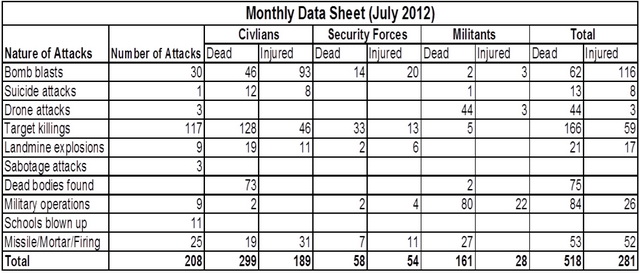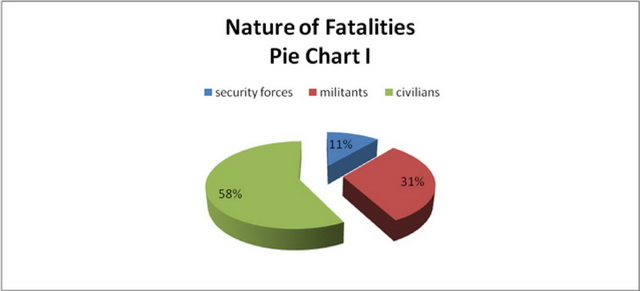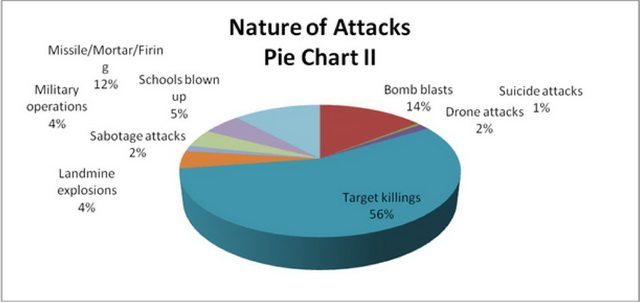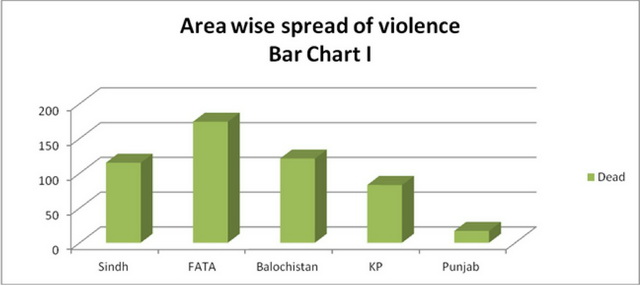The month of July witnessed relatively lower levels of violence across Pakistan, yet, ethno-political violence in Karachi, religio-political terrorism in the Federally Administered Tribal Areas (FATA) and Khyber Pakhtunkhwa (KPK) province, and the nationalist-separatist violence in Baluchistan continued to dominate Pakistan security landscape. Violence, predominantly led by the Tehreeke Taliban Pakistan (TTP) in FATA and KPK, swallowed almost 257 persons during the month under review. As a whole, suggests the data collected through different sources, some 518 people lost their lives in 208 incidents of violence across the country (for details see data sheet). It also underlines that the overall level of violence dropped in July in comparison to June, wherein 545 people perished. Violent clashes, largely of social nature, also left 281 people injured across the country during the reporting month.
As a whole, defenseless civilians remained the primary target of violent actors, borne out by the fact that civilians accounted for more than half of the total deaths in various acts of violence and terrorism across Pakistan. As noted in pie chart I below, civilians accounted for almost 58 percent of the total dead in July. The proportion of the civilian deaths ´ 299 in all – is slightly higher compared to the 51 percent in June. The second highest number of fatalities is of militants i.e. 31 percent of the total dead, followed by 11 percent casualties of the security forces. Almost all these casualties i.e. of the militants and the security forces were recorded in insurgency infested areas of FATA and Balochistan. Furthermore during July, three CIA- operated drone strikes ( compared to six such strikes in June) were reported in different areas of North Waziristan Agency (FATA), leaving as many as 44 suspected militants dead, bringing the total of drone attacks. Between March and July to 21, which killed as many as 167 suspected militants. Meanwhile, carrying on their sabotage campaign against the state infrastructure, militants blew up 11 government schools in different parts of FATA and KP during the course of month. Also, three sabotage attacks were reported in parts of Balochistan, wherein miscreants blew up a gas pipeline anda portion of railway track.
During July, Target-killing was the major cause of deaths. As pie chart II below, depicts that a staggering 32 percent of the total deaths were the direct consequence of unrelenting spree of target killing, wherein 166 persons were shot dead across Pakistan in about 117 incidents. Karachi witnessed the major loss of lives as a result of target killings, with about 77 persons falling victim to the fire from rival groups. Meanwhile, frequent clashes between military and militants were the second major cause of deaths; 84 people were killed, including 80 militants and two security forces personnel in different areas of KP and FATA. Meanwhile, in July, 75 dead bodies were also recovered in different parts of Pakistan, most of them, though found in Karachi, FATA and Baluchistan. The third major cause of the violence was random bomb attacks. In total, 62 persons including 46 civilians and 14 security forces– personnel perished in such attacks. Likewise, one suicide attack left 12 people dead and eight others injured in FATA, the hotbed of al-Qaeda-inspired militancy.
A concise kook into the intensity of violence in different areas of the country suggests that the month of July was not much different from June. During the month of July, violence was evenly spread in FATA, Karachi, KP and Balochistan. Bar chart I below underlines that almost all the deaths were recorded in the said areas under different circumstances. Unlike the previous month, violence swelled to new levels in Balochistan, where the nationalist-separatist insurgency and the state response to that continues to ratchet up violence. This wave of violence in July left about 121 people dead in different violent incidents across the province.
Furthermore, the sporadic episodes of sectarian violence continued to make the minority Shia Muslims bleed. During the current month, 21 people were shot dead out of sectarian motives; in six violent incidents some 17 people belonging to Shia minority sect and four (Sunni Muslims) in Kohat (KP), Quetta (Balochistan) and Karachi (Sindh) lost their lives.. Furthermore, dead bodies of two persons belonging to Shia Muslims of the ethnic Hazara community were found in Mainghundi area of Quetta (Balochistan). Latest trends in sectarian violence suggest that this shade of violence is not subsiding despite tall claims by the government on the issue. On the contrary, neither the police nor the para-military force has sofar made any headway against those involved in sectarian violence in Quetta, the current ground-zero of sectarian violence.
Cumulative data relating to the past three months i.e. May, June, July underscores an alarming trend; with nearly 1593 deaths, the monthly average human loss in various acts of violence comes close to 531. Of these, June was the most violent month, wherein large number of deaths ´ 545 in all – was reported due to the clashes between military and militants in FATA and KP regions. The emerging violent trends suggest that FATA, KP, Balochistan and Karachi remain in the grip of religio-political, nationalistic and ethnic violence. The salient feature of the month was three drone attacks in FATA which killed 44 suspected militants and a suicide attack against KP police wardens, under-training at a police training academy in Lahore (Punjab). TTP spokesman Ehsanullah Ehsan claimed the responsibility for this attack and the continuation of such strikes underlines the scale of the outreach of the TTP militants, who are taking on their chosen targets at will across Pakistan. According to recent media reports, militants have closed their ranks and struck deals among different factions in FATA to multiply their strength for their continued assault on the state security apparatus. In an alarming development, the TTP circulated a letter in late July in Urdu language, asking all religious and religio-political parties as to why they support ‘ an infidel government and the military.’ They also want these parties to openly work for the Shariat enforcement in the country and get rid of infidels , the US collaborators.
This letter, and a couple of statements by spokesman Ehsanullah Ehsan , also underscore a new activism by TTP, which has compiled the letter on behalf of Pak Afghan Taliban and Al Qaeda ( the war against innocent tribals, Mujahideen Taliban, and Al Qaeda is meanwhile over nine years old, says the letter. This army is infidel, traitor and worth revolting against because it a stooge of the Americans. If its legitimate to fight against infidels in Afghanistan, why is it then illegitimate to do the same in Pakistan).
This letter illustrates a new pro-active strategy by the TTP, which seems to enjoy support of Hizbutarir and AL Qaeda ´ primarily because the language of the letter ´ the tone and tenor ´ as well as the content of the message reads like the Al Qaeda and Hizbutahrir propaganda. It’s quite possible that Hizb circulated this letter after conviction last week of Brig Ali Khan and four other officers.
A trail through the violent trends and data of last six months underscore that at a time when country is deeply embroiled in insecurity, the political governments in the Centre and in provincial capitals i.e. Peshawar, Karachi and Quetta appear least concerned about these volatile security conditions in the country.
Sources
- The News
- Dawn
- The Express Tribune
- Pakistan Today
- Daily Times
- The Frontier Post
- Jang (Urdu)
- Daily Mashriq (Urdu)
- Aaj (Urdu)
- The Nation





